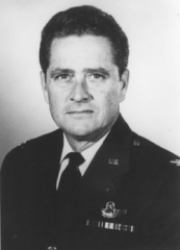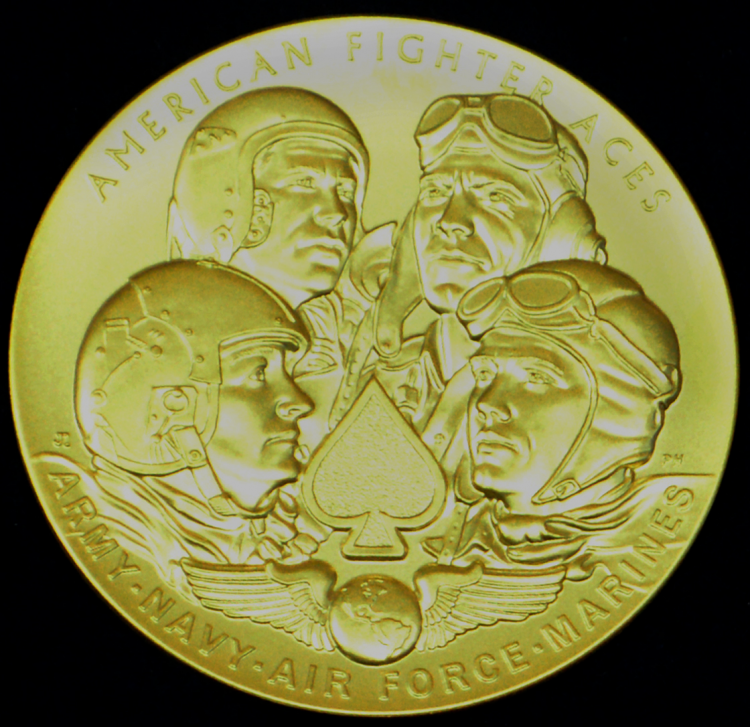
 |
|
|
||
|
William Thomas Whisner, Jr. |
||||
|
Engagements: • World War II (1941 - 1945)• Korean War (1950 - 1953)• Vietnam War (1960 - 1973) |
||||
| Biography: | ||||
|
William Thomas Whisner, Jr. William Thomas Whisner, Jr. was born on 17 October 1923 in Shreveport, LA. Whisner entered the USAAF in March 1942 and earned his wings in March 1943 at age 19. In Europe, he served with the 487th Fighter Squadron, 352d Fighter Group, Eighth Air Force, where he flew 127 combat missions in 456 combat hours in both the P-47 and P-51. In his early days in England, he flew as the wingman of Captain George Preddy. First Lieutenant Whisner was awarded the Silver Star Medal for his actions in strafing ground targets on 24 May 1944. While in a huge air fight near Merseburg, Germany, on 21 November 1944, Captain Whisner shot down 6 enemy aircraft and had a 'probable' destruction of a 7th plane. This action earned him the Distinguished Service Cross. On 1 January 1945 at Asch, Belgium, Captain Whisner shot down 4 enemy aircraft, although his P-51 was severely damaged (he was one of 12 pilots who engaged 115 German airplanes on that New Year's Day). This action earned him a second Distinguished Service Cross. In Korea, Major Whisner flew F-86A fighters with the 25th Fighter-Interceptor Squadron, 4th Fighter Interceptor Group, Fifth Air Force. On 23 February 1952, Maj Whisner shot down a MIG-15 that was attacking a F-86 flown by a member of his own group. That MIG-15 raised his total number of planes destroyed in Korea to five and one-half, which established him as the seventh jet ace of the Korean War. For this he was awarded his third DSC. In all, Whisner downed 21 enemy airplanes. His kill record consisted of 15-1/2 German planes in World War II, sharing a half credit with his then-commander, Captain George Preddy. In the Korean War, he had 5-1/2 kills, becoming the 18th-leading ace among U.S. fighter pilots. Whisner was the only U.S. Air Force pilot to be an Ace in both World War II and the Korean War, and to be awarded the Distinguished Service Cross, the Army Air Force's second highest award for valor, three times. He won the Bendix Trophy Race in 1953, setting a then-record time of 3 hours 5 minutes 45 seconds, for an average speed of 603.5 mph, over a 1,900 mile course, in an F-86F Sabre jet. Whisner served in Vietnam in 1963-64 as Deputy Director Operations, 2nd Air Division. Medals, Awards and Badges Distinguished Service Cross with 2 Bronze Oak Leaf Clusters Distinguished Service Cross Citation - Synopsis (1st of 3 Awards) Captain (Air Corps) William T. Whisner, Jr., United States Army Air Forces, was awarded the Distinguished Service Cross for extraordinary heroism in connection with military operations against an armed enemy while serving as Pilot of a P-51 Fighter Airplane in the 487th Fighter Squadron, 352d Fighter Group, EIGHTH Air Force, in aerial combat against enemy forces on 21 November 1944, during an air mission in the European Theater of Operations. On that date, Captain Whisner led a flight of P-51s on an escort mission to Merseburg, Germany. As the bombers left their target, a large formation of enemy fighters struck. In a linked series of attacks, Whisner shot down four FW-190s in the cover flight and probably got another. With no more than two -190s left in the cover flight he had attacked, Whisner turned his attention to the main enemy formation, exploding an ME-190 that had not dropped its belly tank. Evading three -190s on his tail, he shot down another that was closing on one of his pilots. Whisner was credited with five FW-190s and two probables that day. His score later was revised by the Air Force Historical Research Center to six destroyed, making that day one of the best for any USAAF pilot in the skies over Europe. Captain Whisner's unquestionable valor in aerial combat is in keeping with the highest traditions of the military service and reflects great credit upon himself, the 8th Air Force, and the United States Army Air Forces. General Orders: Headquarters, U.S. Strategic Forces in Europe, General Orders No. 9 (1945) Distinguished Service Cross Citation (2nd of 3 Awards) The President of the United States of America, authorized by Act of Congress, July 9, 1918, takes pleasure in presenting a Bronze Oak Leaf Cluster in lieu of a Second Award of the Distinguished Service Cross to Captain (Air Corps) William T. Whisner, Jr. (ASN: 0-798190/16324A), United States Army Air Forces, for extraordinary heroism in connection with military operations against an armed enemy while serving as Pilot of a P-51 Fighter Airplane in the 487th Fighter Squadron, 352d Fighter Group, EIGHTH Air Force, and as flight leader in a squadron of twelve fighter aircraft taking off on a patrol, 1 January 1945. On this date, as his plane left the ground, Captain Whisner observed 30 hostile fighters preparing to strafe the field. Disregarding the enemy's great superiority in numbers and position, and without waiting to form up with his flight, Captain Whisner attacked alone. In the engagements that followed his aircraft was hit and badly damaged, but determined to defend the field he pressed his attack and destroyed four enemy aircraft. Only after the enemy had been completely dispersed did Captain Whisner halt his pursuit. The extraordinary heroism and determination to destroy the enemy displayed by Captain Whisner on this occasion reflect highest credit upon himself and the Armed Forces of the United States. General Orders: Headquarters, U.S. Strategic Forces in Europe, General Orders No. 34 (April 10, 1945) Distinguished Service Cross Citation (3rd of 3 Awards) The President of the United States of America, under the provisions of the Act of Congress approved July 9, 1918, takes pleasure in presenting a Second Bronze Oak Leaf Cluster in lieu of a Third Award of the Distinguished Service Cross to Major William T. Whisner, Jr., United States Air Force, for extraordinary heroism in connection with military operations against an armed enemy of the United Nations while serving as a Pilot with the 25th Fighter-Interceptor Squadron, 4th Fighter Interceptor Group, FIFTH Air Force, in action against enemy forces in the Republic of Korea on 23 February 1952. On that date Major Whisner destroyed an enemy MIG-15 aircraft attacking an F-86 piloted by a member of his own group. Major Whisner flew to the immediate aid of the pilot in the face of the enemy's great numerical superiority. With an expertly executed maneuver, he attacked the MIG-15 which was pressing full attack on the friendly aircraft and forced the enemy to break away. As Major Whisner bore in to deter the enemy action, another MIG-15 swept down on his tail and began lobbing shells at his aircraft. In spite of the imminent danger of losing his own life, Major Whisner continued to force the first MIG-15 to break away, and, in the face of overwhelming odds, destroyed the enemy aircraft. The downed MIG-15 raised Major Whisner's record of enemy aircraft destruction to five and one-half and established him as the seventh jet ace of the Korean campaign. General Orders: General Headquarters Far East Command: General Orders No. 94 (April 11, 1952) Silver Star Medal Citation The President of the United States of America, authorized by Act of Congress July 9, 1918, takes pleasure in presenting the Silver Star to First Lieutenant (Air Corps) William T. Whisner, Jr. (ASN: 0-798190/16324A), United States Army Air Forces, for gallantry in action against the enemy as a Pilot of a P-51 Fighter Airplane of the 487th Fighter Squadron, 352d Fighter Group, EIGHTH Air Force, on 24 May 1955. On that date, Lieutenant Whisner, with his flight, made a fighter sweep against important military targets deep in Germany. During one such attack against a heavily defended railway junction, his aircraft was seriously damaged. He pressed his attack so close that oil from an exploding locomotive sprayed over the canopy of his plane. Separated from his unit, Lieutenant Whisner continued to make daring strafing attacks in the face of intense enemy fire. His determination to wreak havoc upon the enemy is borne out by the fact that he destroyed the amazing total of ten locomotives, this despite the damaged condition of his aircraft. This outstanding record attests to Lieutenant Whisner's gallantry, indomitable fighting spirit and skill as a pilot. General Orders: Headquarters, 8th Air Force, General Orders No. 470 (July 27, 1944)Congressional Gold Medal The Congressional Gold Medal, created by the U.S. Mint, is the highest civilian honor Congress can give on behalf of the American people. On 20 May 2015, leaders from the U.S. House of Representatives and Senate presented the Congressional Gold Medal to the American Fighter Aces Association at the U.S. Capitol Visitor Center Emancipation Hall. More than 60,000 American fighter pilots engaged in aerial combat during World War I, World War II, the Korean War and the Vietnam War. Of those pilots, only 1,447 earned the title of fighter “Ace” by downing at least five enemy aircraft. At the time of the presentation of the Medal, only 75 of those Aces remained alive. Colonel William Thomas Whisner, Jr. was one of the 1,447 Aces and was credited with downing 21 planes. Death and Burial Colonel William Thomas Whisner, Jr. died on 21 July 1989 in Alexandria, LA, from complications resulting from the sting of a flying insect, a Yellow Jacket. Colonel Whisner was cremated and his ashes were scattered in the Red River. |
||||
| Honoree ID: 3216 | Created by: MHOH | |||
Ribbons
Medals
Badges
Honoree Photos
 |  |  |
 |  |
 |


